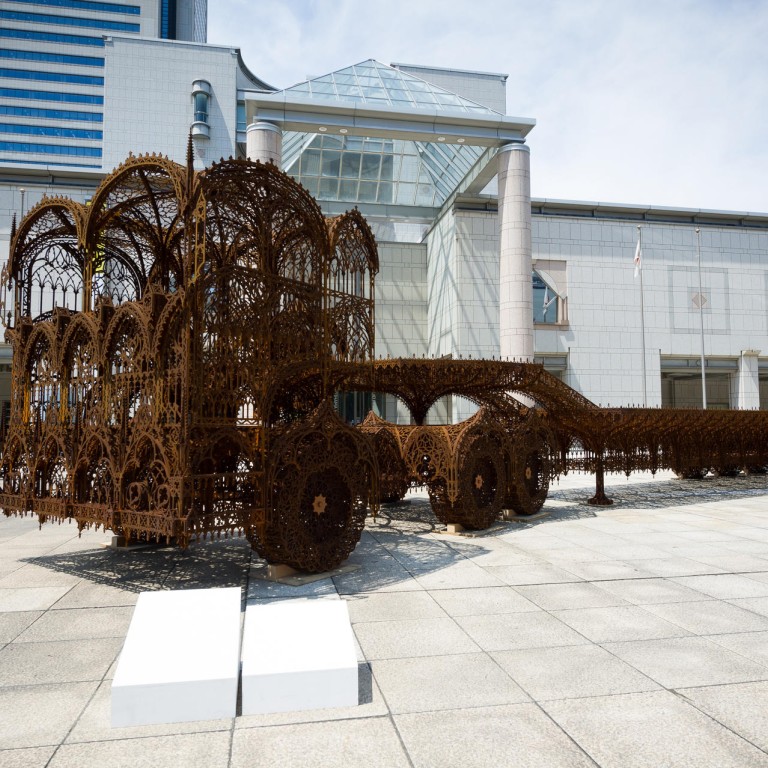
Overblown Triennale in need of a unifying theme
A cluster of visitors is standing near Michael Landy's giant trash can for unwanted art, (2010), at the opening of the Yokohama Triennale 2014 when Belgian artist Wim Delvoye turns to the group and asks: "Did you see the blowjob guy?"
Delvoye - whose contribution to the exhibition is 15 metres of rusting iron sheet metal cut into Gothic patterns and assembled to look like a semi truck, titled (2007) - is referring to a stubble-faced Japanese man standing nearby. He is a typical , or nerd, and his name is Takumi Ueda.
Ueda is holding a canvas of a crudely drawn cartoon of a woman performing oral sex on a man with an excessively long penis. It looked like bathroom graffiti, and he had painted it about 10 years ago, when he was still a virgin. "I have a very small penis," he says, strangely happy to share this private detail. "I have a [psychological] complex." But he says that even though he is throwing out the drawing, he is keeping the condom from the first time he ever had sex.
Putting things behind us, both as individuals and as a society, is one of the intriguing ideas behind Landy's . Realised in Yokohama for the second time, it is a transparent, 30-square-metre plexiglas cage for artists to toss old works into.
The work sits in the centre of the atrium of the Yokohama Museum of Art and greets all visitors to the Triennale. It is a rather ominous way to open Japan's most important exhibition of contemporary art.
For many in Japan and East Asia, the Yokohama Triennale, which runs to November 3, is a bellwether of the latest ideas in the international art world. Featuring more than 400 works by 79 artists - from contemporaries such as Landy and Delvoye to historical figures like Andy Warhol and Rene Magritte - it is supposed to be a survey of all that is new in the art world. Yet the work is a call to destroy old ideas. Even the exhibition's theme seems a meditation for end-times: "ART Fahrenheit 451: Sailing into the Sea of Oblivion."
The theme comes from artistic director Yasumasa Morimura, a star artist known for posing in photos as Marilyn Monroe, the Mona Lisa, Marcel Duchamp and other icons from pop culture and art history. He is represented by top galleries, such as Luhring Augustine in New York, so as the curator he brings star power, but what about ideas?
In the Triennale handbook, Morimura writes that the exhibition is about "things one does not talk about" or "must not speak about", and about "the trivial and the useless" and "failure and defeat".
At the Triennale's opening press conference, a reporter asked Morimura, now 63 and looking like a well-preserved game show host, whether he chose the theme out of a sense of personal crisis and a fear his own work would be forgotten.
Morimura's answer was vague. He repeatedly described the curatorial process as "intuitive" and said he hoped to get rid of the "borderline" between the contemporary and the historical. He finally backpedalled into a tautology, saying: "You could say I just collected my favourite things."
These "favourite things" include a bewildering array of objects, videos and installations. Among the historical works, there are (semen on paper) by Warhol, obscure early photographs by surrealist painter Magritte, and minimalist canvases from Kazimir Malevich, Agnes Martin and Blinky Palermo.
Contemporary works include a "technicolor meth lab" of blown glass by Elias Hansen and a video of military aircraft splashing into the ocean by fellow American Dihn Q. Le. For an installation by a group called the Temporary Foundation, a Japanese hip hop artist will rap the Japanese constitution.
These are among the more interesting works, although their meanings are often opaque. All are putatively reflections on "oblivion", but the problem is that these interpretations come more from the artists than the curator. As a result, there is little to tie them together.
Landy's reminds us that breaking with the past can open a path to the future. After Ueda chucks his scribble, he says it's a useful purge. "At first it was very difficult but now I am OK." Maybe next time he'll toss the condom too.

